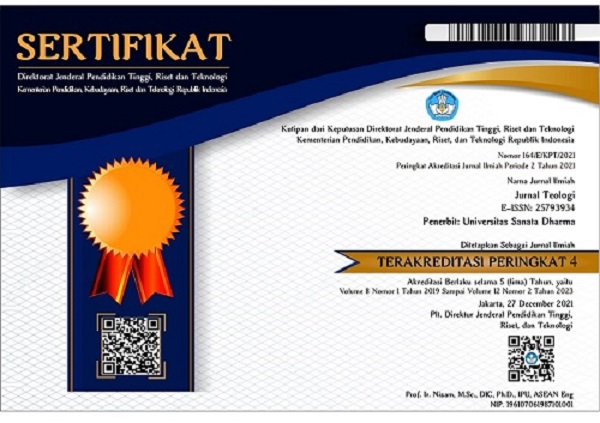MEMAKNAI HIDUP DI DEPAN KEMATIAN DALAM REFLEKSI KOMPARATIF HEIDEGGER DAN RAHNER
(1) Universitas Atma Jaya Yogyakarta
(*) Corresponding Author
Abstract
Abstract
Death is usually seen as the end of everything. So many people try and build an effort to run from death in so many ways, both conventional and modern, from the traditional one to the high technology usage. However, whatever we do, we finally face death. The fear of death sometimes makes humans run from it, make a tranquilization, an inauthentic attitude, or according to Heidegger “inauthenticity of being-toward-death”. Consequently, so many opportunities for a meaningful life are left behind. By using the qualitative method through literature research, this inquiry comes to a reflection of the meaning of life in the face of death in the frame of comparative study. This paper is based on Heidegger’s argument in his book Sein und Zeit (SZ). A new terminology he built, Sein-zum-Tode, stimulates various questions vis-a-vis the reality of life encountered by the entire society in today’s world. Are there any relevances of his argument on death to build a meaningful life here and now? To make a balance of reflection, this paper presents the theological perspective of Karl Rahner, Heidegger’s former student. By comparing these two thinkers, between a philosopher and a theologian, the author comes to a reflection that the mystery of death must be understood in relation to the creative and meaningful life in this world
Abstraksi
Kematian biasanya dipandang sebagai akhir dari segalanya. Begitu banyak orang mencoba dan membangun upaya lari dari kematian dengan berbagai cara, baik konvensional maupun modern, dari yang tradisional hingga penggunaan teknologi tinggi. Namun, apapun yang kita lakukan, kita akhirnya menghadapi kematian. Rasa takut akan kematian terkadang membuat manusia lari darinya, membuat suatu ketenangan, suatu sikap yang tidak autentik, atau menurut Heidegger “ketidakotentikan keberadaan menuju kematian”. Akibatnya, begitu banyak peluang untuk kehidupan yang bermakna tertinggal. Dengan menggunakan metode kualitatif melalui penelitian kepustakaan, penelitian ini sampai pada refleksi makna hidup menghadapi kematian dalam kerangka studi banding. Tulisan ini didasarkan pada argumen Heidegger dalam bukunya Sein und Zeit (SZ). Terminologi baru yang ia bangun, Sein-zum-Tode, merangsang berbagai pertanyaan vis-a-vis realitas kehidupan yang dihadapi oleh seluruh masyarakat di dunia saat ini. Apakah ada relevansi argumennya tentang kematian untuk membangun kehidupan yang bermakna di sini dan sekarang? Untuk menyeimbangkan refleksi, makalah ini menyajikan perspektif teologis Karl Rahner, mantan murid Heidegger. Dengan membandingkan dua pemikir ini, antara seorang filsuf dan seorang teolog, penulis sampai pada refleksi bahwa misteri kematian harus dipahami dalam kaitannya dengan kehidupan yang kreatif dan bermakna di dunia ini.
Keywords
Full Text:
PDF (Bahasa Indonesia)References
Beverinotti, Matías. “Beyond Work: Life, Death, and Reproduction and the Post-work Society.” Discourse 43, no. 2 (2021): 264–85.
Coyne, Ryan. “Bearers of Transience: Simmel and Heidegger on Death and Immortality.” Human Studies 41, no. 1 (2018): 59–78.
Davies, Douglas. A Brief History of Death. Oxford: Blackwell Publishing, 2005.
Demske, James M. Being, Man, and Death. A Key to Heidegger. Kentucky: The University Press of Kentucky, 1970.
Fahrudin, Adi. “Fenomena Bunuh Diri di Gunung Kidul: Catatan Tersisa dari Lapangan”. Sosio Informa Vol 17, No 1 (2012).
Falque, Emmanuel, and George Hughes. “Death and Its Possibilities.” In The Guide to Gethsemane: Anxiety, Suffering, Death, 1st ed., Fordham University Press, (2019): 57-68.
Ferrugia, Mario. “Karl Rahner on Concupis-cence: Between Aquinas and Heidegger.” Gregorianum 86, no. 2 (2005): 330–56.
Fontana, Leandro Luis Bedin. “Human Transcendence as a Locus of Revelation and Foundation for Theological Work: Implications from Rahner’s Hearer of the Word.” Teocomunicação 48.1 (2018): 82-96.
Fritz, Peter Joseph. “Karl Rahner’s Theological Logic, Phenomenology, and Anticipation.” Theological Studies 80.1 (2019): 57-78.
Grifin, Andrew. “Stephen Hawking: What the professor said about his own death”. Independent (2018). Diakses pada 07.02.2022. https://www.independent.co.uk/news/science/stephen-hawking-death-dies-atheist-god-brief-history-time-quotes-explained-a8254846.html.
Halim, Abd. dan Abdul Mudjib Adnan. “Prob-lematika Hukum dan Ideologi Islam Radikal (Studi Bom Bunuh Diri Surabaya)”. Ulul Albab: Jurnal Studi dan Penelitian Hukum Islam, Vol 2, No. 1 (2018).
Hardiman, Fransiskus Budi. Heidegger dan Mistik Keseharian. Jakarta: KPG, 2014.
Hayasaki, Erika. “Has this scientist finally found the fountain of youth?”. MIT Technology Review, August 2019. Diakses dari: https://www.technologyreview.com/2019/08/08/65461/scientist-fountain-of-youth-epigenome/#Echobox=1565271457 (28/05/2022).
Heidegger, Martin. Sein und Zeit. Tübingen: Max Niemeyer Verlag, 1927.
Heidegger, Martin. Being and Time. Diterjemahkan oleh John Macquarrie dan Edward Robinson. Cambridge: Blackwell Publishing, 2001.
Linnane, Brian F. “Dying with Christ: Rahner’s Ethics of Discipleship.” The Journal of Religion 81, no. 2 (2001): 228–48.
Nasution, Yenni Aristia. “Fenomena Kasus Bunuh Diri Akibat Ijime pada Anak SMP di Jepang”. Ayumi: Jurnal Budaya, Bahasa dan Sastra, Vol 7, No 2 (2020).
Pabubung, Michael Reskiantio. “ ‘Human Dignity’ dalam Pemikiran Yohanes Paulus II dan Relevansi untuk Dunia Masa Kini”. Jurnal Teologi (Journal of Theology) 10.1 (2021): 49-70.
Pabubung, Michael Reskiantio. “Epistemologi Kecerdasan Buatan (AI) dan Pentingnya Ilmu Etika dalam Pendidikan Interdisipliner.” Jurnal Filsafat Indonesia 4.2 (2021): 152-159.
Pattison, George. Heidegger on Death. Critical Theological Essay. London: Ashgate, 2013.
Phipps, Gregory. “Death and the Search for Heideggerian Authenticity in ‘No Country for Old Men’.” The Cormac McCarthy Journal 18, no. 1 (2020): 37–55.
Phan, Peter C. “Eschatology”. Dalam The Cambridge Companion to Karl Rahner. Cambridge: Cambridge University Press, 2005.
Putt, B. Keith, ed. “Toward a Postmodern Theology of the Cross: Augustine, Heidegger, Derrida.” In The Essential Caputo: Selected Writings, Indiana: Indiana University Press, 2018, 266-281.
Rahner, Karl. Theological Investigation. Vol 4. London: Darton, Longman & Todd, 1961.
Rahner, Karl. On the Theology of Death. London: Burns and Oates, 1962.
Rahner, Karl. Foundation of Christian Faith. London: Darton, Longman & Todd, 1978.
Richardson, John. Heidegger. New York: Routledge, 2012.
Schalow, Frank dan Alfred Denker. Historical Dictionary of Heidegger. Toronto: Scarecrow Press Inc, 2010.
Sheehan, Thomas. Making Sense of Heidegger. A Paradigm Shift. London: Rowman & Littlefield, 2015.
White, Carol J. “Dasein, Existence, and Death”. Dalam Heidegger Reexamined, Volume 1: Dasein, Authenticity, Death. London: Routledge Taylor and Francis Group, 2002.
Williams, John R. Martin Heidegger’s Philosophy of Religion. T.K.: SR Supplements, 1977.
Wolfe, Judith. Heidegger’s Eschatology. Oxford: Oxford University Press, 2013.
DOI: https://doi.org/10.24071/jt.v11i01.4391
Refbacks
- There are currently no refbacks.

This work is licensed under a Creative Commons Attribution-ShareAlike 4.0 International License.
.jpg)
Indexed and abstracted in:
P-ISSN: 2302 - 5476 (Validity starting Volume 2012-10-05)
E-ISSN: 2579 - 3934 (Validity starting Volume 6, No. 1, Mei 2017)
Jurnal Teologi (Journal of Theology) by Faculty of Theology Sanata Dharma University

This work is licensed under a Creative Commons Attribution-ShareAlike 4.0 International License














